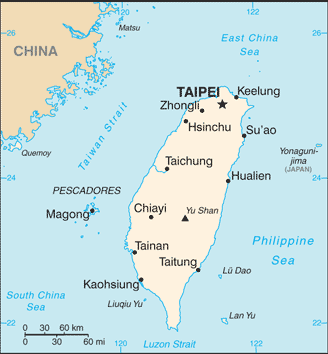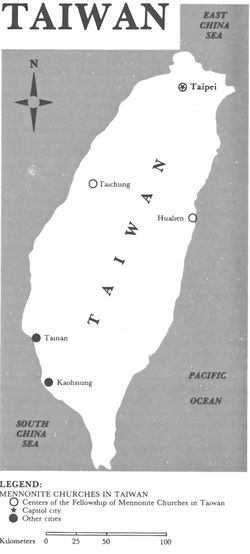Taiwan

Introduction
Taiwan (officially the Republic of China [ROC]) is an island located 160 km (100 miles) off the southeast coast of China, opposite Fukien Province, astride the Tropic of Cancer halfway between Japan and the Philippines. Two-thirds of the island of 35,883 km2 (13,855 square miles) is mountainous. Formerly known as Formosa (Portuguese for "beautiful island"), Taiwan (Chinese for "terraced bay") is governed by the Nationalist Chinese party (Kuomingtang) as the Republic of China. In 2013 Taiwan had an estimated population of 23,373,517.
The island was first occupied by Taiwanese aborigines. In the 17th century both the Dutch and the Spanish established trading outposts on the island. In 1662 the Dutch, who had earlier expelled the Spanish, were expelled by pro-Ming loyalists from mainland China, and the first Han Chinese kingdom was established. The Han Chinese continued to settle on the island and became the majority population. Taiwan came under Japanese control in 1895 but reverted to China in 1945. When the Communist Party of China established the People's Republic of China in 1949, the Republic of China (Nationalist Chinese) government of Chiang Kai-shek relocated to Taiwan.
In 2009 the Han Chinese constituted 98% of Taiwan's population, including the Hokkien (70%), the Hakka (14%), both early Han Chinese immigrants, and later Han Chinese emigrants from mainland China that settled in Taiwan after 1945 (14%). The other 2% were Aborigines, composed of 14 Austronesian ethnic groups. Mandarin Chinese is the official language, though the Taiwanese dialect is the mother tongue of the majority.
Buddhism, Taoism, and religious Confucianism along with popular folk religion are practiced by the people of Taiwan. Only three percent of the population was considered Christian in 1986. The Presbyterian Church of England began mission work in southern Taiwan in 1865 under James Maxwell, and in 1872 George MacKay from the Presbyterian Church of Canada began medical and evangelistic work in northern Taiwan. In 1986 the Presbyterian Church was the largest and oldest Taiwanese Christian church. Following World War II, numerous other mission groups entered Taiwan to establish churches.
In 2005 81.3% of the population of Taiwan was religious, and 14-18% were non-religious. The largest religious groups were Buddhism (35.1%), Taoism (33%), Yiguandao (3.5%), Protestantism (2.6%), and Roman Catholicism (1.3%). The majority of Taiwanese people usually combine the secular moral teachings of Confucianism with their religion.
Mennonites in Taiwan
Mennonite Central Committee (MCC) was invited by the Presbyterian Church to begin relief and medical work in Taiwan in 1948, and the General Conference Mennonite mission followed with church planting work in 1954. In 1986 there were 17 Mennonite congregations of the Fellowship of Mennonite Churches in Taiwan located in three major cities of Taiwan. In addition the Mennonite Christian Hospital was located on the east coast.
2020 Update
In 1948, Mennonite Central Committee (MCC) was invited by the Presbyterian Church in Taiwan to establish the Mennonite Mountain Medical Team for mobile service in the mountain areas. MCC envisaged its work as Christian service “in the Name of Christ” and its programs built up a respect for Mennonites throughout the island. This team was directed by Glen D. Graber, and set up provisional clinics. They made circuits around the mountain areas every year diagnosing and treating illnesses and providing food and hygiene education. Under the leadership of Dr. Roland Engle and Dr. Roland P. Brown, the mountain clinic at Hualien finally expanded in 1954 to become a hospital with a 35-bed capacity. The Mennonite Christian Hospital (MCH) became a milestone of the medical care of the Mennonites in Taiwan.
Due to the expansion of medical work, the General Conference Mennonite Board of Missions (later the Commission on Overseas Mission, or COM) decided to take over the work of MCC and to plant churches in 1953. The Mennonites did not initially plant churches among the indigenous people, who were more receptive of the Gospel, because of an agreement that had been reached with the Presbyterian missionary James Dickson. But in the end, the Mennonites decided to evangelize the Taiwanese-speakers. The first Mennonite church in Taiwan, the so-called Bamboo Church, began in 7 November 1954 in Glen Graber’s garage, which had been built from bamboo. The church, Linsen Road Mennonite Church, was officially formed on 12 March 1955 in Taichong.
Hugh Sprunger and his family were dispatched to Taiwan to help establish the church and later founded other churches. Lu Chun-Tiong, a Presbyterian pastor with a folk-like charisma, attracted many Taiwanese people who were baptized. He was the most important contributor in the early period of the Mennonite church in Taiwan. The quality and quantity of the Mennonite church in Taiwan eventually improved because of new social services such as the extension of hospitals, the establishment of nursing schools, the airing of the English radio program “Daily Thoughts” and the “Christian Literature Center” bookstore.
The Fellowship of Mennonite Churches in Taiwan (FOMCIT), was officially established at the fifth annual conference of Mennonite churches in 1963. The Protestant churches in Taiwan grew quickly during this period, among both the mainlanders and the indigenous tribes. The Protestant community shot up from about 37,000 members after the war to over 200,000 in 1960. The unstable political situation for Taiwan resulted in a feeling of uncertainty among both Taiwanese and mainland people. Thus, they became “fertile soil” for the Gospel. The percentage of Christians on the island rose from one percent in 1945 to five percent in 1965. The Mennonite Church in Taiwan also grew rapidly during this period. With the support of Commission on Overseas Mission, new Mennonite churches were gradually established. According to the annual report of FOMCIT, there were 16 congregations with a total membership of 903 in 1978.
In 1994, COM announced that its task in Taiwan was finished. FOMCIT became a mission partner of COM from then on. In the meantime, FOMCIT also achieved its Economic Independence Project which was begun in March 1983. FOMCIT became self-supporting, self-governing, and self-propagating. But the more difficult task, becoming self-theologizing, was still in process.
From 1977 on, the social services of FOMCIT kept developing. Otto Dirks founded the New Dawn Retardation Developmental Center in 1977 in Hualien for taking care of those suffering physical or mental disabilities. In 1992, the Taiwanese government allocated 126 million Taiwanese dollars (about four million US dollars) to reconstruct its office into a seven-story building because of New Dawn’s respected service. Now New Dawn, with a progressive vision, is a pioneer in professional skills-training for the disabled in east Taiwan. In 1986 the Good Shepherd Center was established in Hualien for rescuing child prostitutes, sexually abused young girls and women who are victims of domestic violence; it ran a halfway house in support of these people.
From 2000 to 2012 the Fellowship of Mennonite Churches in Taiwan has congregations located in three major urban areas: Taipei and Taoyuan, Taichung, and Hualien.
| Denomination | Congregations in 2000 |
Members in 2000 |
Congregations in 2006 |
Members in 2006 |
Congregations in 2012 |
Members in 2012 |
Congregations in 2020 |
Members in 2020 |
|---|---|---|---|---|---|---|---|---|
| Fellowship of Mennonite Churches in Taiwan | 18 | 1,028 | 20 | 1,658 | 20 | 1,879 | 23 | 1,230 |
Bibliography
Kraybill, Paul N., ed. Mennonite World Handbook. Lombard, IL: Mennonite World Conference, 1978: 183-187.
Mennonite World Conference. "2000 Asia/Pacific Mennonite & Brethren in Christ Churches." Web. 2 March 2011. http://www.mwc-cmm.org/Directory/2000asiapacific.html http://www.mwc-cmm.org/Directory/2000asiapacific.html. [Broken Link].
Mennonite World Conference. "Mennonite and Brethren in Christ Churches Worldwide, 2006: Asia & Pacific." Web. 2 March 2011. http://www.mwc-cmm.org/Directory/2006asiapacific.pdf http://www.mwc-cmm.org/Directory/2006asiapacific.pdf. [Broken Link].
Mennonite World Conference. World Directory = Directorio mundial = Répertoire mondial 2012: Mennonite, Brethren in Christ and Related Churches = Iglesias Menonitas, de los Hermanos en Cristo y afines = Églises Mennonites, Frères en Christ et Apparentées. Kitchener, ON: Mennonite World Conference, 2012: 12.
Mennonite World Handbook Supplement. Strasbourg, France, and Lombard, IL: Mennonite World Conference, 1984: 41.
Pan, Chiou-Lang. "The Mennonite churches in Chinese-speaking areas" in ''Churches engage Asian traditions," John A. Lapp and C. Arnold Snyder, eds. Global Mennonite History Series. Intercourse, Pa.: Good Books, 2011: 243-250.
Sawatzky, Sheldon V. "The Gateway of Promise: A Study of the Taiwan Mennonite Church and the Factors Affecting Its Growth." MA thesis, Fuller Theological Seminary, 1970.
Wikipedia. "Taiwan." 9 May 2014. Web. 19 May 2014. https://en.wikipedia.org/wiki/Taiwan.
| Author(s) | Sheldon V Sawatzky |
|---|---|
| Date Published | May 2014 |
Cite This Article
MLA style
Sawatzky, Sheldon V. "Taiwan." Global Anabaptist Mennonite Encyclopedia Online. May 2014. Web. 18 Apr 2024. https://gameo.org/index.php?title=Taiwan&oldid=171173.
APA style
Sawatzky, Sheldon V. (May 2014). Taiwan. Global Anabaptist Mennonite Encyclopedia Online. Retrieved 18 April 2024, from https://gameo.org/index.php?title=Taiwan&oldid=171173.
Adapted by permission of Herald Press, Harrisonburg, Virginia, from Mennonite Encyclopedia, Vol. 5, pp. 870-871. All rights reserved.
©1996-2024 by the Global Anabaptist Mennonite Encyclopedia Online. All rights reserved.


